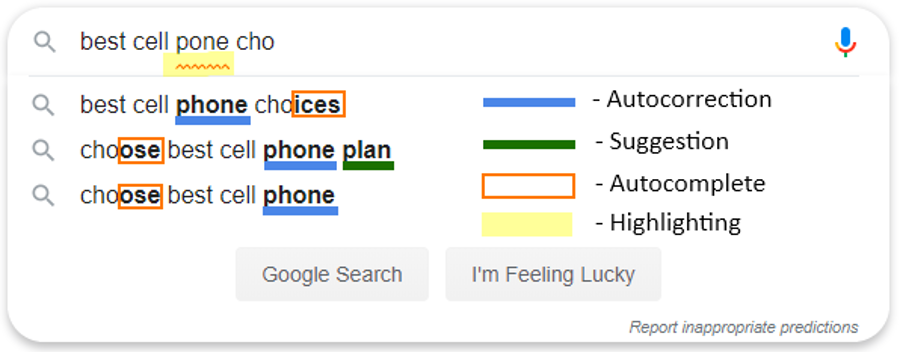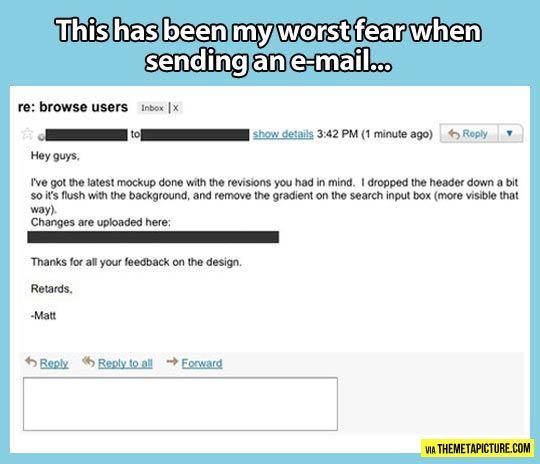
Autocorrect: the ultimate influencer
Autocorrect. A widely used tool that dates all the way back to the 1960s. Nowadays, it is hard to imagine a life where a text is sent without being checked by autocorrect. However, what do we know about this software? And is it really just very handy or is it a mysterious tool ominously tracking our literate behavior? In which ways does autocorrect influence our digital literacy lives?
The history of autocorrect
In order to dive deeper into the subject, we must first define what we mean by "autocorrect". There are multiple synonyms to the term, such as spelling correct, text correction, or typo tolerance (Gregdevogo, February 6). According to Computer Hope (2017), "AutoCorrect is a software feature commonly found in word processing programs, such as Microsoft Word. As the name implies, this feature automatically corrects misspellings and common typos". It follows that autocorrect helps language users with correcting typos and also changes mistakes into words that the software is familiar with.
Autocorrect helps language users with correcting typos and also changes mistakes into words that it is familiar with.
As Stevens (2017) claims, "the system is descriptive at the surface; i.e., it amends and programs its rules based on trends in usage that it finds in the data it collects" from the language users. According to the New York Times (D. Engber, 2014), Warren Teitelman was the person who first came up with the "Do What I Mean"-philosophy where programs should recognize obvious mistakes. Through this particular program, an obvious error could be recognized immediately and would thereby be corrected. Once this system was implemented, the auto-correction function became a well-known companion to everyone’s writing. With the invention of touch-tone telephones, everybody became familiar with a tool with which spelling errors would be corrected. Nowadays, it is hard to think of texting someone or typing a message without using this handy feature.
Autocorrect approaches
The aforementioned function -where the spelling checker corrects your written words- is only one of the ways in which autocorrect works. As is most commonly understood, this is the correction that is made automatically after you press the spacebar and your written word changes into another (correct) word.
A different way in which autocorrect can approach text in terms of user experience is through a search engine where "it takes [text] as a given and gives you suggestions afterwards" (Gredevogo, n.d.). For example, when typing "best cell pone cho", the first suggestion Google gives is “best cell phone choices”. Here, Google is assuming the user meant "phone" instead of "pone". As seen in Figure 1, the dark blue line represents Google's autocorrection. When a user types a word wrong, that word is underlined in red. The last three letters of this search don’t form a word yet, “cho”. Here, Google automatically completes words that you could possibly use for your search. This is seen in the orange squares in Firgure 1. The search engine tries to guess the word the user meant.

Figure 1: Autocorrection in Google searches, image drawn from Gregdevego (n.d.)
As Lee (n.d.) notes, "You don't have to spell correctly to search productively on the Web if you use Google as your search engine". Indeed, people can search for certain words but type them wrong in the first place. Google's autocorrect algorithm can predict the word that the user intended to use (see Figure 2). "These suggestions or predictions (as Google names that) are based on related web searches, your browsing history, and Google’s website ranking" (Gredevogo, February 6).

Figure 2: Googling "aple laptop"
Autocorrect, companies and users
Interestingly, almost every website has a different approach to the use of autocorrect. Whereas Google tries to help users find the right word, and therefore suggests words and corrects typos, Amazon is more focused on the commercial aspect of autocorrect. As an article on Towards data science (Gredevogo, n.d.) explains “In terms of Amazon’s autocorrect implementation it consists of all the previously mentioned components, but since it’s a marketplace its suggestions ranking formula seems to include the factor of how attractive a suggestion can be to you in terms of sales”. And it is not just Amazon that uses a different type of autocorrect. Pinterest, for example, also uses its own algorithm with autocorrect “based on internal domain/pins/pinners relevance” (Gredevogo, n.d.).

Figure 3: Pinterest's autocorrect and suggestions
At this stage, it is important to underline how much we as users have grown accustomed and attached to this tool. The degree of its influence is evident in the fact that autocorrect comes naturally: people aren’t aware of its action anymore. Further, autocorrect also has some serious consequences for literacy, one of them being that its use might contribute to certain dialects disappearing.
Autocorrect and literacy
A great example that serves to visualize the influence autocorrect has in our society is found in a study on the impact of digital tools on student writing (Purcell, Buchanan & Friedrich, 2013). Survey results revealed that 68% out of 2,462 participants say that “digital tools make students more likely—as opposed to less likely or having no impact—to take shortcuts and not put effort into their writing” and “46% say these tools make students more likely to ‘write too fast and be careless’” (Purcell et al., 2013). The automatic function of correcting our spelling takes away the element of our own assessment in learning to formulate and recognize correct spelling (Sanchez, 2016).
The automatic function of correcting our spelling takes away the element of our own assessment in learning to formulate and recognize correct spelling.
One may go so far as to argue that autocorrect makes literate language users in westernised societies less engaged or even lazy. Users are less willing to put much effort into writing and spelling correctly. Still, digital technologies like autocorrect are an important tool for becoming a digitally- and socially-included person (Ragnedda & Mutsvairo, 2018) and they bring many advantages for individuals and groups. Digital inclusion is defined as the “ability of individuals and groups to access and use information and communication technologies” (Ragnedda & Mutsvairo, 2018). Ragnedda and Mutsvairo (2018) further note that this related to connectivity, capability, content, confidence and continuity; as they put it, “Digital inclusion is a matter of access and connectivity but also a matter of skills, knowledge, opportunities, motivations and capacities to use ICTs to improve the quality of life”. So, in the end, even though autocorrect might be a tool that makes people less engaged, the technology still connects people by making communication more inclusive.
What makes this so interesting is that, although we don't want to put in the work, society still very much cares about correct spelling. According to the BBC (2017), "A survey of 5,500 American singles in 2016 by online dating site Match.com found that 39% judged the suitability of candidates by their grasp of grammar – ranking that more important than their smile, dress sense or even the state of their teeth". Your image and persuasion will rely heavy on your ability to spell. People with an inability to spell suffer a prejudice of being ignorant and slovenly (Horobin, 2013). In addition, poor spelling is seen as an index of lower intelligence and educational and social status (Horobin, 2013), which makes people seem less fit for a "happy ever after".

Figure 4: E-mail autocorrect mistakes
Dialects disappearing
On top of all this, Way (2019) insightfully notes that autocorrect is “killing the vernacular”. When one looks at what Way denounces more closely, this does come to make some sense. Autocorrect is forcing one "correct" way of writing (spelling) and is unable to recognize all, if any, dialects. Is our urge for correct spelling strong enough that we would be willing to sacrifice linguistic innovation in the process?
Vernaculars or dialects are often based on geographical regions, whereby a particular region may have its own language and traditional communication range (“Dialect”, n.d.). Due to their non-dominant role and the small scale of their use, dialects lose favor over standard language. In our modern digitalized society, the vernacular is no longer as supported. This is evident in the lack of vernacular vocabulary in autocorrection, which results in a chicken-or-egg problem. The lack of the possibility to use the vernacular leads to its lesser use and so on. Many typical dialectal forms of expression become language history, whereas the "correct" language that is embedded in autocorrection takes over.
Consequences for education
As mentioned above, autocorrect might have an influence on our activity as language users. We may become lazy since we don't necessarily have to pay attention to what they are writing as autocorrect will correct our typos. This begs the question of what this entails for the writing skills of children. Will autocorrect make children lazy too, influencing the development of their writing skills? Is it still worth learning children any spelling or grammatical rules if it will all be done for them in the near future?
According to associate professor of English Cynthia Ryan (Bakken, 2014), these changes should be embraced. "New technologies will, as they always have, influence how we gain and use knowledge". She continues: “When students text, they’re writing in a particular genre and for an informal audience. Texting as a genre has space considerations and expectations, which warrant using abbreviations for phrases such as LOL, symbols like 2 for 'too', and just as few characters as possible" (Bakken, 2014). Nevertheless, Bakken (2014) writes that "technology will not replace good, old-fashioned writing". Ryan, a teacher herself, claims that students should never be fully dependent on technology. "Context is key, and neither autocorrect, a thesaurus nor any other kind of resource can be counted on to do the work for the writer". Autocorrect should be seen as a double-edged sword. On the one hand, it is a tool that makes us more skillful and productive, but on the other, it calls into question the necessity of learning grammar at all and spending that much time and money on something that could or will be done for you.
Interesting scenarios shaped by autocorrect
Autocorrect is an undeniably useful tool that helps a significant number of people in their writing. However, it might also cause problems. On one occasion, a controversial incident included Hillary Clinton, where Google was blamed for "hiding negative autocomplete results for Hilary Clinton" (Kastrenakes, 2016). According to Kastrenakes (2016) a "video pointed out that Google doesn't suggest "Hillary Clinton crimes" when you type in "Hillary Clinton cri," whereas both Yahoo and Bing do". Nevertheless, Google fully denied that this was true. Kastrenakes (2016) also defends Google on the matter: “Google does, for all people, filter out "offensive or disparaging" search predictions — and "crime" is one of the words Google consistently removes”. Another argument given in the article is that most people usually only type Clinton without the first name which makes it harder to reach the negative news.
Another case in which autocorrect comes into play is during intense chatting through mobile phones. Many of you may recognize the struggle of wanting to type a certain word or name that keeps being corrected. For example, autocorrect loves to change the name Kirsten, into "korsten" (meaning: crusts), resulting in a very uncharming nickname. Most of the time we notice such unfortunate corrections, but when we don’t, this can result in some pretty entertaining conversations. For years, such mistakes have been getting shared all over the internet as very successful memes, or even on television like in the "Clumsy Thumbsy" segment on the Ellen DeGeneres Show (TheEllenShow, 2001). These memes are so successful as a topic to laugh to because of their relatability. Most can empathize with a situation where what they sent was not what they meant.

Figure 5: Funny autocorrected messages from Damnyouautocorrect.com
Conclusion
So you might wonder, after seeing so many sides to autocorrect, is there anything simply good to it? Very much so! Autocorrect remains a helpful tool for people with disabilities, such as dyslexia (Hiscox, Leonaviciute & Humby, 2014). Autocorrect is also seen by many as empowering because it positively influences their productivity (Branscombe, 2017; Davis, 2002). It is argued that one’s time checking spelling decreases and time focusing on your message's content increases. Regardless of its drawbacks, this type of technology will remain a valuable helping hand, but keep in mind that you will always know your own idiolect better than autocorrect does.
References
Bakken, J. (may 2014). Could texting and autocorrect affect kids' writing skills? Retrieved on March 22, 2020
Branscombe, M. (Febuary 6, 2017). Office 365 tip: Using 'Add to AutoCorrect' to make you more productive. ZDNet. Retrieved on April 17, 2020
Computer Hope (April 10, 2017). AutoCorrect. Retrieved on March 2, 2020, from
Davis, J. (March 19, 2002). The importance of using AutoCorrect. TechRepublic. Retrieved on April 17, 2020, from https://www.techrepublic.com/article/the-importance-of-using-autocorrect/
Denn, R. (January 29, 2019). In the era of spellcheck and auto-correct, does it matter that my son can’t spell? The Washington Post. Retrieved on March 2, 2020
Dialect (n.d.). Wikipedia. Retrieved on March 22, 2020
Engber, D. (2014). Who made that autocorrect? New York Times Magazine. Retrieved on March 2, 2020
Google (2020). Google. Retrieved on March 2, 2020
Gregdevogo (February 6, n.d.). Autocorrect in Google, Amazon and Pinterest and how to write your own one. Retrieved on March 2, 2020
Hiscox, L., Leonaviciute, E., Humby, T. (2014). The effects of automatic spelling correction software on understanding and comprehension in compensated dyslexia: improved recall following dictation. Dyslexia 20(3) , pp. 208-224. Retrieved on April 17, 2020
Horobin, S. (2013). Does spelling matter? Oxford University Press.
K, Way. (October, 2019). Autocorrect is for Cowards. Vice Media Group. Retrieved on March 21, 2020, from
K. Purcell, J. Buchanan and L. Friedrich. (July, 2013). The impact of digital tools on student writing and how writing is taught in schools. Pew Research Center. Retrieved on March 21, 2020
Kastrenakes, J. (June 2016). Google denies altering search suggestions for Hillary Clinton. Retrieved on March 22, 2020
Lee, K. (n.d.). How does Google's Auto-Correct work? Retrieved on March 22, 2020,
Morrison, L. (August 2017). The true importance of good spelling. Retrieved on March 2, 2020
Ragnedda, M., Mutsvairo, B. (2018), Digital inclusion: Empowering people through information and communication technologies (ICTs). In M. Ragnedda, and B. Mutsvairo, (Eds.), Digital inclusion. An international comparative analysis (pp. vii-xx), London.
Sanchez, B. (September, 2016). This is why you should turn off autocorrect. Indiana University, The Odyssey. Retrieved on March 22, 2020
Stevens, J. (September 2017). How autocorrect influences language. Retrieved on March 2, 2020
TheEllenShow. (September, 2011). Clumsy Thumbsy [video file]. Retrieved on March 22, 2020